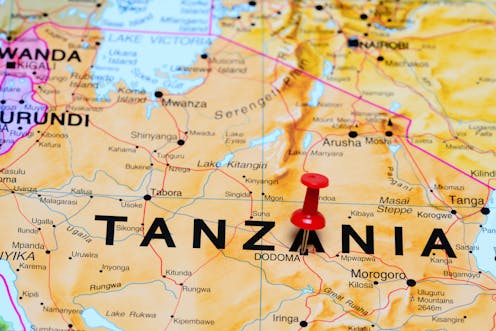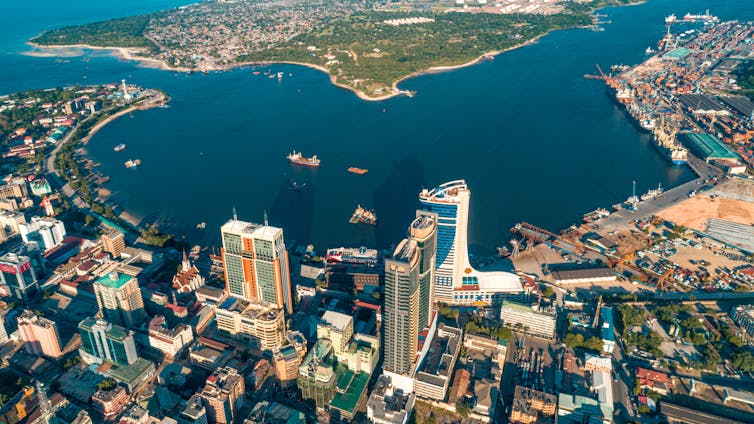
Tanzania designated Dodoma as its new capital in place of the seaside city of Dar es Salaam following a public referendum 50 years ago. Since then, the country has made small steps towards this goal – including the relocation of Parliament in 2017 – but Dodoma remained the national capital only in name. With the inauguration of the new presidential offices in Dodoma in May 2023, the transition to the capital is now all but complete. Ambrose Kessy, a public administration expert, answers the key questions.
What’s the background to Tanzania’s capital city relocation?
The history of Tanzania’s capital city is lengthy and complex. It stretches back to the German colonial era. To take advantage of Dar es Salaam’s protected harbour, the German government chose Dar es Salaam as the capital of German East Africa rather than the well-established port of Bagamoyo a mere 60km north.
The first president of Tanzania, Julius Kambarage Nyerere, announced the planned move from Dar es Salaam to Dodoma in 1973. A state agency and ministry were established to oversee the implementation of the plan. It was decided that Dar es Salaam would continue to serve as the nation’s principal port and commercial capital. This choice posed a difficult development challenge. Government services and resources had to be relocated and infrastructure had to be built. A comprehensive array of administrative functions were needed in Dodoma.
Several observers of Tanzania’s social, economic, and political environment wondered why such a step was taken in the context of Tanzania’s development philosophy of socialism and self-reliance. Dodoma was a capital nobody desired, and some called it a political hoax or a white elephant project.
I recently published a paper outlining the pivotal role played by President John Pombe Magufuli (2015-2021) and his successor President Samia Suluhu Hassan to make the move a reality. It took Magufuli’s bold actions and Suluhu’s persistence to end decades of apathy.
Why was the relocation necessary?
The reasons are complex. The following are some of the most important factors that informed the decision:
Overcrowding and strain on infrastructure: Dar es Salaam has a population of 5,383,728 people and is suffering from overcrowding and infrastructural strain. Moving the capital aimed to redistribute some of the population and ease pressure on resources and public services in Dar es Salaam. The rate of population growth in Dar es Salaam region has decreased from 5.6% in 2012 to 2.1% in 2022.
Uneven development: Tanzania’s development was heavily concentrated in Dar es Salaam and other coastal regions. The move aimed to stimulate economic activity in previously neglected regions.
Accessibility and national unity: By relocating the capital to a more central location, the government aimed to make it more accessible to all and foster national unity and inclusiveness.
Efficiency of government operations: The idea was to reduce the cost and time associated with travel between Dar es Salaam and other parts of the country for government officials.

Why has it taken so long?
Despite the clear benefits, the relocation process has been slow due to a combination of political, economic, and logistical factors. The national leadership lacked the commitment. Successive governments delayed the move owing to competing priorities like developing education and health.
Economic challenges have also played a role, as Tanzania has had to carefully allocate its limited budget. Moving an entire capital city also poses logistical challenges.
But the 50-year journey culminated on 20 May 2023, with the opening of the new State House building in Chamwino, Dodoma. The building will hold presidential offices and the official home of the president.
What challenges does Dodoma face as the new capital?
The city must develop the necessary infrastructure, including transport systems, water supply and housing, to accommodate government workers and residents.
Two districts in Dodoma region, Dodoma and Chamwino, comprise the new capital city with roughly 765,179 and 486,176 people respectively. Service provision in Dodoma has been improving but still lags behind Dar es Salaam. It is anticipated that by the end of 2023, more than 1,500 officials will have moved to Dodoma as part of the relocation.
The new city has a deficiency in utilities and community infrastructure to meet rapidly rising demand, notably in solid and liquid waste management, education, healthcare, and integrated public transport. For example, only 6% of the Dodoma city population is linked to the sewage system, with the other 94% relying on various methods of waste water disposal.
The government has made some good efforts to address these challenges. Detailed design work for the construction of 63 ring roads in Dodoma city has been completed. And the city council has built several commuter transport routes within the region to serve residents in new areas. The government has also started work on a new international airport at Msalato, Dodoma. The new airport will have a three-storey terminal for departing and arriving passengers, with a capacity of 1,500,000 persons per year.
Healthcare facilities in Dodoma have increased from 429 in the year starting June 2020 to 467 in the year ending June 2023. Water supply has increased over the period from 61.5 million litres per day on average to 67.8 million litres per day.
Despite these efforts by the government, Dodoma might not be fully ready to handle a massive population influx from other regions. It must attract businesses and investors to create a self-sustaining economy. The city will need to address potential social issues, such as the need for more accommodation and recreational facilities, as the population grows. It will also need a strong services sector.
What can Tanzania learn from other African countries?
Nigeria’s change of capital from Lagos to Abuja in the 1990s can provide insights into the planning and execution of such a relocation. Abuja was a purpose-built city.
Key takeaways include the importance of involving stakeholders in the planning process, ensuring adequate infrastructure development, and promoting the new capital as a business hub to attract investment.
Proper planning and financial management are crucial. The relocation process can be costly, as seen in Nigeria. Tanzania should budget carefully for the move while ensuring transparency and accountability in financial management.
The country can also learn from South Africa’s approach of developing more than one city as a capital. Tanzania should continue to invest in the development of Dar es Salaam as an economic hub and maximise its growth potential.
By considering these lessons, Tanzania can ensure a successful transition, and promote long-term growth and development in Dodoma and the whole country.
Ambrose T. Kessy does not work for, consult, own shares in or receive funding from any company or organization that would benefit from this article, and has disclosed no relevant affiliations beyond their academic appointment.
This article was originally published on The Conversation. Read the original article.







